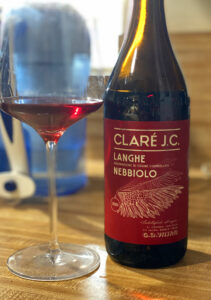2020 G.D. Vajra, Langhe Nebbiolo DOC “Claré J.C.” Piedmonte, Italy.
The new release of Vajra’s unique Claré J.C. Langhe Nebbiolo is bright ruby in the glass and zesty on the lighter framed spicy palate with a spritz of effervescence and racy ripe red fruits that give pure Nebbiolo flavors, but without the usual gripping tannins, making for a distinctly fresh and quaffable wine to be enjoyed with a slight chill and with non pretense meals. This wine picks up the floral nature of the Nebbiolo with seeped rose petal aromatics and a crisply dry, but fruity array of red berries, pomegranate, grilled orange, tart cherry and garden strawberries along with dried herbs, Asian spices and star anise. This wine recalls an almost forgotten era and style of local Nebbiolo that dates back to the 1600s with a short maceration period and bottled quickly capturing the natural CO2, similar to what we see in Spain’s basque Txakolinas. Giuseppe Vajra’s one of the region’s most outstanding talents and his latest collection offers quality throughout the range from the serious and cellar worthy cru Barolo bottlings to the more ready to go wines like this one, and I can almost never not mention his thrilling dry Riesling, one of my absolute favorites.
The ever innovative Vajra family, who pioneered organic farming in Barolo in the early 1970s and who invested in high elevation parcels, knowing that they would be greatly beneficial with the ever warming climate, painstakingly researched the historical recipe for this old style Nebbiolo, finding the winemaking protocol that follows the 1606 writings of G.B. Croce, jeweler of the House of Savoia, who chronicled this delicacy and who noted that the wines were bottled soon after the fermentation so as to retain a gentle off-dry finish, with a zippy spritz and a lovely energy. This 2020 vintage, which was one of the longest in recent times and helped add vigorous natural acidity while providing ripe density, was done with about 18% of the grapes, which came from younger vines within the Langhe DOC, fermented in whole clusters with the rest being de-stemmed berries, all in tank. Then, as the winery notes, after the noted shorter maceration, the wine was then racked to finish fermentation off the skins, for a gentler extraction and was bottled in February following harvest. This wine, which I really chilled down on a warm evening went beautifully with a spicy pasta rigatoni with Calabrian peppers, and I highly recommend it for the contented smiles it provokes.
($24 Est.) 90 Points, grapelive
